5 Word Challenge
This time you have 5 words that must be put into your writing. They can be in any order but must all be there. You can use any type of writing structure. The words are:
Pepper Crocodile Orange Forgot Soft
Picture
Write about the picture below. Look carefully - what do you notice about the bridge. You might like to do a 5 sentence challenge or you might like to write a narrative which tells the story about why the bridge is like it is.

Algebra
We are starting this term with algebra.
Beetle Wheels
How many wheels does a VW beetle have?
How many wheels are there on 2 beetles? How did you work that out?
You could have - used materials, skip counted or used your times tables.
Copy and complete the table.
| Number of Beetle Wheels | |
| Number of Beetles | Number of Wheels |
| 1 | 4 |
| 2 | |
| 3 | |
| 4 | |
| 5 | |
Now try the tricycle table.
| Number of Tricycle Wheels | |
| Number of Tricycles | Number of Wheels |
| 1 | 3 |
| 2 | |
| 3 | |
| 4 | |
| 5 | |
Give the spider legs table a go.
| Number of Spider legs | |
| Number of Spiders | Number of Legs |
| 1 | 8 |
| 2 | |
| 3 | |
| 4 | |
| 5 | |
Letter Patterns
We can make the letter l using tiles.
How many tiles do you need to make the fourth, fifth, sixth and seventh?
Use the table to record your answers.
| ‘+’number | 1 | 2 | 3 | 4 | 5 | 6 | 7 |
| number of tiles |
Now try this one. Look carefully to see how many are added each time.

| ‘+’number | 1 | 2 | 3 | 4 | 5 | 6 | 7 |
| number of tiles |
Now try this one.

| ‘+’number | 1 | 2 | 3 | 4 | 5 | 6 | 7 |
| number of tiles |
Can you see what the pattern is?
How many tiles would be in the 10th 'plus' shape?
What 'plus' in the sequence would you be able to make with 25 tiles?
Measurement
We are learning about measurement in maths at the moment. Have a go measuring length, width and height at home. If you don't have a ruler you can use non-conventional measure like hands, feet, a book, pen, etc. Remember you need to write down what you used, e.g. 6 pens long.
Time is something we can measure using hours, minutes and seconds. If you can't already tell the time this is something to work on at home. Start with the hour, then half past and quarter past and quarter to. Once you have these you can work on the minutes in between. Remember we can use an analogue clock (the one with hands) or a digital clock. We need to be able to tell the time on both. If you can already tell the time you can work on measuring time. For example, how many minutes from 4 o'clock to half past 4?
Websites with time learning activities:
http://www.abcya.com/telling_time.htm
http://resources.woodlands-junior.kent.sch.uk/maths/measures.htm
http://www.sheppardsoftware.com/mathgames/earlymath/on_time_game1.htm
Google 'Telling time online games' to find some other activities.
Procedure Writing
We have been learning how to write instructions. Use the 'Writing Structures' page next to the 'Home Learning' page to help you with the structure. Some ideas for writing could be:
* How to clean your teeth
* Making a bed
* Making a toasted sandwich
* How to play a game you like playing.
* How to ride a bike/skateboard or scooter (don't forget your safety gear).
Great to see those children who have been learning their times tables! It really make maths easier in Year 4 if you know them.
'Let's Get Connected
As we are thinking about our connections to other countries I thought you could find out how people say hello in different countries. You can practise using them to answer the roll in the morning.
Fractions
Have a go at drawing circles, squares and rectangles and dividing them into fractions. Colour in and draw the following fractions:
One half, three quarters, two fifths, one eighth, four tenths, 1/4, 4/5, 5/8, 7/10
Now try finding fractions of a set (remember to find equipment if you need help):
The bottom number (denominator) tells you how many groups you need to make.
e.g. 1/2 of 12= You need to make 2 equal groups. How many in each group?
****** ****** Answer is 6.
1/3 of 9 = You need .to make 3 equal groups. How many in each group?
*** *** *** Answer is 3.
Try these:
1/2 of 10= 1/2 of 16= 1/2 of 20= 1/4 of 8= 1/4 of 12= 1/4 of 16=
1/3 of 12= 1/3 of 18= 1/5 of 20= 1/5 of 25= Extra 1/6 of 30= 1/8 of 24=
Use your drawing to help you solve the following problems: e.g. 3/4 + 1/4= 1
1/2 + _____ = 1 1/4+ _____ = 1 2/4 + ______ = 1 2/5+ _____=1 6/8 + _____=1
6/10 + _____=1 3/10 + ____=1 Extra 7/12+___= 1 14/20+____= 23/30+___=1
5 Sentence Challenge
You have 5 words and they each need to be put into a sentence. If you like, you could make a short story of them but you don’t have to if you prefer to just have 5 separate sentences. The words are:
Silver Snake Smiled Sausages Silly
News ReporterSee if you can find some news to bring along to share for news. Write down who, what, where, when, why and how so you know what happened. Remember you can use the free newspapers, TV, radio or the internet. Kiwi kids news is a good place to find news that is easier for kids to understand. http://www.kiwikidsnews.co.nz/. There is a link on our blog.
Times tables
Keep practising those times tables. Use the Tables Mountain you have taken home this week.
5 Sentence Challenge
So, you can write about this picture or you may had picnics, parties and celebrations of your own that you can tell us about. Do make sure you remember those full stops and capital letters that make your sentences really good. Remember we are learning how to add thoughts and feelings so try and have at least one sentence that includes how the bears or you are feeling.
Student Jokes
I was inspired by 'Our Awesome Grade 3 Blog!' from Mrs Motta's class in Canada so I am putting a new page on our blog. See if you can find a joke you would like to share. Just make sure it is 'appropriate'. Think 'Would I tell this joke to Mr Oliver?' When you have a good joke let me know and you can put it on the blog.
Reading A Story
Choose a picture book you enjoy reading and practice reading it out loud until you know it well. Think about being able to read it fluently. This means you can read it smoothly, effortlessly and without having to sound out words. When you have good fluency and expression you make the story enjoyable for others to listen to.
When you think you can read it fluently bring it to school and you can read it to the class.

5 Sentence Challenge
Write 5 sentences about the picture above. Remember sentences start with a capital letter and end with punctuation like a full stop, question mark or exclamation mark. Try and think about how you can add detail
to your sentences by writing compound sentences (use conjunctions like and, because, until, or but) to include more than 1 idea.
Multiplication
We have started to learn about multiplication. You really need to know how to skip count in 2s, 5s, and 10s forwards and backwards. If you can't do this to 100 you need to practise at home.
e.g. 2, 4, 6, 8 ... 5, 10, 15, 20 ... 100, 90, 80, 70 ...
If you can skip count you need to start working on your times tables. Start with your 2x (which is just like your doubles) then 5x and 10x.
Studyladder has some good practice activities. The link is on the class blog. Otherwise practice writing them out and saying them out loud. Get an adult to test you on them. You can buy practice books from bookshops and probably The Warehouse.
Geometry
2D shapes - draw and label the following shapes: circle, oval, rectangle, triangle, diamond, pentagon, hexagon, octagon. Can you find out the names for 7, 9 and 10 sided 2D shapes?
3D shapes - Drawing 3D shapes is not easy. Can you draw a cube, rectangular prism, cone and cylinder?
Have a look at home and write lists of the different things you can find that are 3D shapes:
Cube Rectangular Prisms Cones Cylinders

5 Sentence + Challenge to add extra information (detail)
Write a sentence about the picture above and leave 3 lines underneath the sentence. Now write your next sentence and leave three lines underneath it. Repeat this until you have 5 sentences.
Adding Detail Now go back and read your first sentence and underneath it write another sentence that tells the reader more about your idea. Then do this for all your sentences.
For example:
A man is pushing a trolley filled with suitcases. First sentence
The suitcases are very heavy so he has to use his strong muscles. Added detail
Don't forget your capital letters and full stops and that your sentences have to make sense.
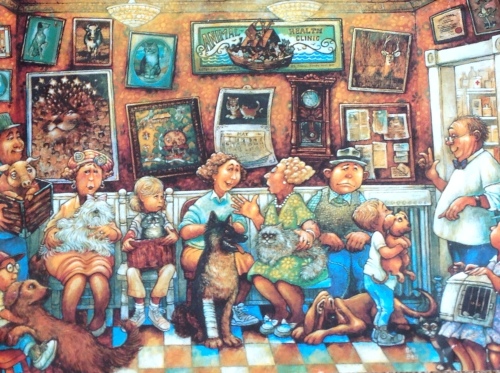
5 Sentence Challenge
Write 5 sentences about the picture above. Don't forget your capital letters and full stops and that your sentences have to make sense. Try and use interesting words that describe the detail. Think about precise adjectives (describing words) and verbs (doing words).
For example;
The fluffy white cat, with the bushy tail, is lying quietly on the lady's lap waiting patiently to see the vet.
Writing a Report about Eels or Stingrays
If you look on the page 'Writing Structures' above you will see a reminder on how to write a report.
We have been learning how to write a report.
Either
Watch the short video clip about eels (on 'Video Clips' page above) and write down the main facts under the headings:
- Where they live (habitat)
- What they look like
- What they eat
- Who their predators are and why
and then use this information to write your report on eels. You can include other information you know or find out.
Use our information ( below) from watching the video in class and our brainstorm, and write a report about stingrays.
They are a fish - related to sharks
Where they live (Habitat)
In sea - warmer waters
Rocky shores
Sandy beaches
Close to shore
Sit on bottom of ocean
Appearance
Wide flat body
Can grow up to 1.8 metres wide
Fins length of body
Have no bones - cartilage instead (like your nose)
Colour - matches mud or sand hide in
Mouth, nostrils, gills underside (bottom) of body
Eyes on top
Behaviour
Curious
Swoop and glide in water - either flap fins (fly in the water) or use whole body to swim
Not aggressive or dangerous unless alarmed
Protect themselves - flick tail, sting with barb
Camouflage on bottom of ocean - hide from sharks
Food
Can't see food
Eat clams, mussels, shrimp, oysters, crabs
Strong jaw - crush food
Observational Drawing
When you are doing observational drawing you have to look carefully and closely to draw what you can see. Have a go at drawing these pictures. You might like to colour them in afterwards.
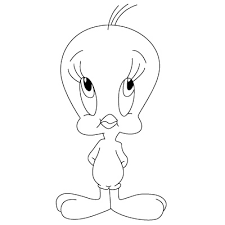
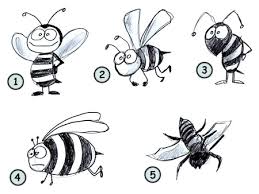
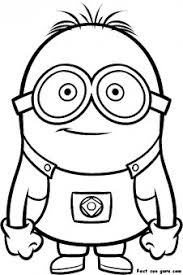
Comment on the Blog
Go onto our blog and have a look at some other people's learning blogs in our class. After you have had a look you can leave them a comment. Remember when we write comments we need to write proper sentences with capital letters and full stops and they make sense. All the comments will be approved by me before they appear on the blog. Remember to only write your first name.
Home Learning Challenge 15 March
Read, draw and write - Read the whole paragraph before you start drawing.
The little girl in the long, striped dress is sitting on a tall chair at a long table. In the middle of the table is a big three-layered cake that has five flickering candles on top. Above the table are different shaped balloons hanging from the ceiling. On the floor by the girl's chair is a large box with a colourful bow. At the far end of the table there is a huge, black spider wearing a party hat with streamers coming out the top. On the wall behind the table there is a banner that says 'Happy Birthday Incy Wincy'.
1. Draw a picture showing what you have just read.
2. Write a list of all the adjectives (describing words) in the story, e.g. long.
3. Write a list of all the nouns (naming words) in the story, e.g. girl, chair.
4. Write the next 5 sentences for the story. (What might be in the box? What type of cake is it? Will any more guests come to the party? Will they play any games?)
Home Learning Challenge - 2 March
Questions - Have an adult read you a book and then write a question starting with each of the following words: Who? What? When? Where? Why? and How? Remember your why and how questions shouldn't have a simple one word answer.
Interview- Write 5-6 questions that you could ask a family member about when they were a child. It could be about where they lived, toys, games, sports, holiday, pets, jobs, or favourite things. These are just some ideas, I'm sure you can think of some other things. Once you have written your questions then you can interview (ask) the person your questions and record their answer.
Maths - 'Make 10' is a fun card game to play. With a pack of cards take out all the picture cards and deal each player 5 cards. The remaining cards go into a pile in the centre. If you have any pairs that add up to 10 you then put them down in front of you. It is then played like fish where you ask another player for a card you need to make 10, e.g. if you have a 4 you will ask for a 6. If they don't have it you take a card from the pile in the centre. Winner has the most pairs at the end.
Home Learning Challenge - 25 February
Making 10 or 20 - How many different ways can you make 10 by adding 2 numbers? How about making 20?
Statistics - Can you complete a statistical investigation at home? Remember you need to create a tally chart, collect your data and present it as a bar or pictograph. Some ideas could be ... Number of rooms in your house, different type of toys you have, insects you find in the garden, a favourite thing for your family e.g. Colour, food, etc (you could include grandparents, Aunties, Uncles, cousins, etc).
Story - Can you write an adventure story with a pirate and a map? You could always try a 10 minute Quickwrite, and see how many words you can write.
Home Learning E Challenge
Ear words - Write down as many words you can with the 'ear sound' in them. Don't forget the words spelt with 'air'. Draw a picture of 3 our your 'ear' words.
Exciting Elephant Escape - Write a story about an elephant escaping from the zoo. Remember to think about the words you are choosing (precise nouns, verbs and adjectives) and to try and add the extra detail (information).
Eating Habits - Write down or draw 5 different foods that are healthy for you to eat.
What do you think junk food is?
Name 5 different junk foods.
When is it okay to have junk food?
Eleven times tables - We know there is an easy pattern for our x10, i.e. 1x10=10, 2x10=20, 3x10=30, 4x10=40. Can you see the pattern and finish it for the x11?
1x11=11, 2x11=22, 3x11=33, 4x11= , 5x11= , 6x11= , 7x11= , 8x11= , 9x11= ,10x11=, 11x11= , 12x11=
Events - Look in the local newspaper - don't forget the free ones that are delivered. Write about 2 events that have happened recently. Remember who, what, where, when, why and how.
Home Learning D Challenge
Diary - Keep a diary for a week. Include things like what
- time you get up and go to bed
- you had for breakfast, lunch and dinner
- important or interesting things that happened during the day
- friends you played with
- tv programmes you watched, games you played, books you read
Draw - Practice your times tables by drawing groups to show your understanding, e.g. 4 groups of 2 cats equals 8 cats.
Design - Create a design and colour it
- 6 parts of it green
- 3 parts black
- 7 parts red
- 5 parts blue
- 4 parts orange
- Leave any other parts white
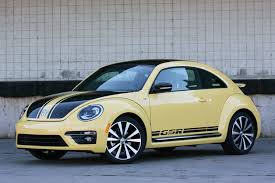

No comments:
Post a Comment